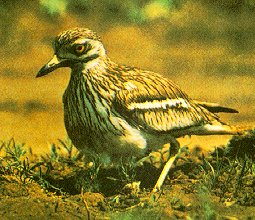 Synonyms: Charadrius
oedicnemus, Oedicnemus crepitans.
Synonyms: Charadrius
oedicnemus, Oedicnemus crepitans.Burhinus oedicnemus (Linnaeus, 1758)
 Synonyms: Charadrius
oedicnemus, Oedicnemus crepitans.
Synonyms: Charadrius
oedicnemus, Oedicnemus crepitans.
Common names: Engl: Stone-curlew; Russ: Avdotka; Turk: Kocagos; Ukr: Lezhen'.
Order (Scientific): BURHINIDAE.
Family (Scientific): BURHINUS.
Taxonomic descriptions: Preliminarily estimated to be around 180-240 pairs.
 IUCN
Status:
IUCN
Status:
World level: VU
Black Sea Regional level: VU
Subregion level: VU
Distribution:
Habitats type, Critical habitats, Limiting factors: Breeding and post-breeding habitats do not differ. They are salinas, sandy beaches, spits and islands, stony areas with low and thinned out mosaic vegetation or without any at all, including those subjected to human transformation (pastures, agricultural fields, open cast-mines, young gardens, vineyards).
Biology: Breeding, summering and migratory species. In the southern parts of the region arrives by the end of March - beginning of April. At the end of the first ten daysof April appears in the northern ones. The nest is a trampled down plot on the ground encircled by vegetation from the previous year, small stones, clods of earth, dry cattle droppings. Egg-laying starts from the beginning of the second ten days of April. The clutch consists of 1-3 eggs and is incubated for 26 days. Parents share their duties equally. Fledglings are observed in July. In the post-breeding period birds occur in small groups (2-5, sometimes more) or solitarily. Autumn migration takes place from September to the first part of October. Food is mostly animal (insects, molluscs, small vertebrates).
Population trends: Insufficient extension of the breeding range due to the ability to breed in agricultural fields and pastures with low grazing.
Threats: Disturbance, clutch and chick losses due to over-grazing and recreation pressure, killing by people, increase in predation (Crows (Corvidae), Raccoon Dogs (Nyctereutes procyonoides), Red Foxes (Vulpes vulpes), domestic dogs.
Conservation measures taken: There is no real protection. Most pairs breed outside the protected areas.
Conservation measures proposed: Expansion of the protected areas for the breeding sites, limitation of grazing therein, reduction in the predators' numbers.
References:
Compiled by: Y.Andryushchenko.